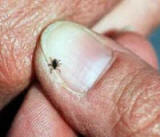Chronic Lymes disease
Search Cidpusa web

Abstract: Return of muscle strength and function after use of intravenous immunoglobulin for Lyme disease-associated acute demyelinating polyneuropathy
CIDP SUPPORT GROUP
09-26-2003
Arch Phys Med Rehabil. 2003 Sep;84(9):E34-E35. Cynthia Majerske, MD (University of Pittsburgh,
Pittsburgh, PA);
Patient: A 58-year-old man with babesiosis and Lyme disease.
Case Description: The patient, who had a history of splenectomy, was admitted with diffuse myalgias, fevers, and chills. He had a history of foreign and domestic travel 6 weeks prior. He was diagnosed with babesiosis.
The patient's muscle strength on admission was 5/5 throughout, but declined during his acute care stay. The patient was transferred to the acute rehabilitation floor, where he demonstrated noted weakness primarily in the lower extremities.
Through his first week of rehabilitation, he became significantly weaker in hip flexors and knee extensors (to 2+/5) as well as developed proximal upper-extremity weakness (to 3+/5) for shoulder flexion. An electromyogram (EMG) on day 14 showed primary demyelinating sensorimotor polyneuropathy. Sural nerve biopsy was unremarkable. Western blot for Lyme disease returned positive. He was started on intravenous Ceftriaxone, yet deterioration of muscle strength and function was noted.
An EMG on day 30 showed continued evidence of demyelinating polyneuropathy with significantly prolonged F-wave latencies in the upper extremities and moderate worsening in conduction velocities in 3 of 4 nerves. He was started on intravenous immunoglobulin (IVIG) on day 33 and received a total of 5 doses over 5 days.
Assessment/Results: Patient was discharged on day 38 with improving muscle strength and he was able to ambulate 150ft using a wheeled walker with supervision. At follow-up 8 weeks later, muscle strength had fully returned.
Discussion: This case illustrates that Lyme disease-associated demyelinating polyneuropathy may be treated with IVIG. The potential use of IVIG in this population is based on its efficacy in those with acute demyelinating neuropathy of alternative etiologies.
Conclusion: IVIG can be considered as a treatment option for demyelinating polyneuropathy associated with Lyme disease.
See how to get IVIg approved for Lyme
PMID: 13680780 [PubMed - as supplied by publisher]
continue to page-2 to learn how to become a superhuman